
Concept explainers
(a)
Interpretation:
It is to be determined whether and how[DK1] the given ether can be produced from a
Concept introduction:
The Williamson ether synthesis is the most convenient method for an ether synthesis. In this synthesis, an
Answer to Problem 10.16P
The given ether can be produced successfully from Williamson ether synthesis as below:

Explanation of Solution
The structure of the given ether is
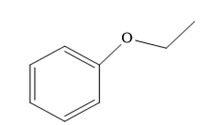
In this ether, one of the R groups is a phenyl ring, and the other is an ethyl group.
So, there are two routes to produce the desired ether by Williamson ether synthesis. Route one is discussed below.
Route I:

This is a feasible synthesis because the phenoxide ion is a good nucleophile, and the halide group attached on the primary carbon atom (primary alkyl halide) is a good substrate for a
The second possible route is discussed below.
Route II:

In this method, the halide group is on sp2 hybridized carbon, which is not acceptable for an
As Williamson ether synthesis is an
(b)
Interpretation:
It is to be determined whether and how[DK2] the given ether can be produced from a Williamson ether synthesis. And if there are two feasible syntheses for the given ether, it is to be determined which one is more preferable.
Concept introduction:
The Williamson ether synthesis is the most convenient method for an ether synthesis. In this synthesis, an alkyl halide
Answer to Problem 10.16P
The given ether cannot be synthesized by Williamson ether synthesis.
Explanation of Solution
The structure of the given ether is
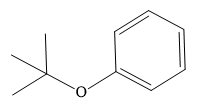
In this ether, one of the R groups is a phenyl ring, and the other is a tertiary butyl group. Those two groups would be the potential alkyl halides for a Williamson ether synthesis reaction. Route I is shown below:
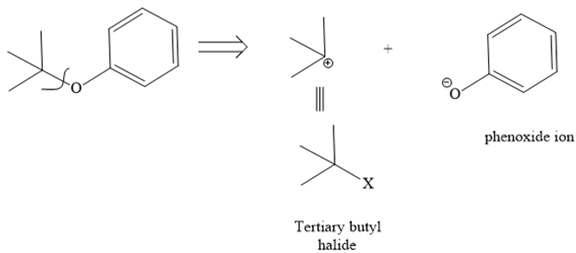
The retrosynthesis suggests that the given ether can be synthesized from a tertiary butyl halide as a substrate and a phenoxide ion as a nucleophile. But the alkyl halide has a leaving group on the tertiary carbon, so it will not follow an
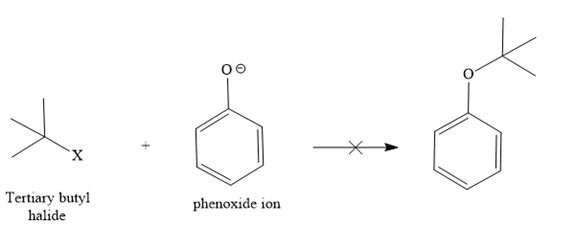
Instead, it shows an E1 reaction with the phenoxide ion because the phenoxide ion acts as a base instead of the nucleophile due to bulkiness.

The second route is not acceptable because the positive charge comes on [DK4] the carbon atom of a phenyl ring, which is already electron-rich and sp2, which is not good for the
Route II:
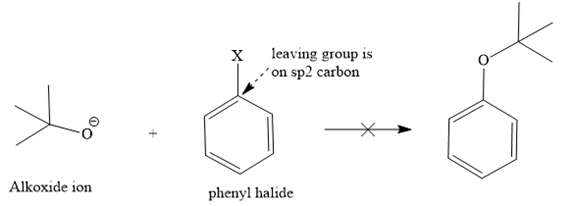
Since both routes do not give the desired ether as a product via
As Williamson ether synthesis is an
(c)
Interpretation:
It is to be determined whether and how[DK5] the given ether can be produced from a Williamson ether synthesis. And if there are two feasible syntheses for the given ether, it is to be determined which one is more preferable.
Concept introduction:
The Williamson ether synthesis is the most convenient method for an ether synthesis. In this synthesis, an alkyl halide
Answer to Problem 10.16P
The given ether can be successfully produced from a Williamson ether synthesis via two routes as below:
Route I:

Route II:

The first route is more preferable as it makes use of a primary alkyl halide as a substrate.
Explanation of Solution
The given ether is
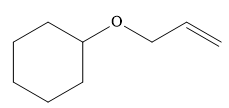
One R group in the given ether is cyclohexane while the other is an allyl group. Both of these R groups can be potentially used as substrates in the Williamson ether synthesis. Route I is shown below:

In this route, the leaving group (halogen atom, X) is on the primary carbon, and an alkoxide ion is also a good nucleophile, so the reaction can proceed through
The other route for the synthesis of the given ether is shown below:
Route II:

In this route, the leaving group (halogen atom, X) is on the secondary carbon, and an alkoxide ion is also a good nucleophile, so the reaction can proceed through
Note that both routes are feasible for the given ether synthesis, but the substrate of both routes is different. In the first route, the substrate (alkyl halide) has a leaving group on primary carbon while in the second route it is on the secondary carbon. Since an
As Williamson ether synthesis is an
Want to see more full solutions like this?
Chapter 10 Solutions
Organic Chemistry: Principles And Mechanisms: Study Guide/solutions Manual (second)
- What is the IP for a amino acid- give an example what are the types of amino acids What are the structures of proteins The N-Terminal analysis by the Edman method shows saralasin contains sarcosine at the N-terminus. Partial hydrolysis of saralasin with dilute hydrochloric acid yields the following fragments: Try-Val-His Sar-Arg-Val His-Pro-Ala Val- Tyr- Val Arg-Val-Tyr What is the structure of saralasin?arrow_forward> aw the missing intermediates 1 and 2, plus the final product 3, of this synthesis: 1. Eto 1. EtO¯ H3O+ 1 2 2. PrBr 2. PrBr Δ You can draw the three structures in any arrangement you like. 3 Click and drag to start drawing a structure. Explanation Check 2025 McGraw Hill LLC. All Rights Reserved. Terms of Use Privacarrow_forwardThere are various factors that affect an equilibrium. Give 3 of these factors and explain using examples andequations how an equilibrium is affected by these factors. Please remember that this is a communication question so that you are communicating your understanding of the factors that affect and equilibrium.arrow_forward
- EEZE LETCHUP ID Draw the most likely conjugate base resulting from this acid-base reaction. Include all lone pairs. Ignore inorganic byproducts. Drawing く NaOCH2CH3 :0: :0: 狗arrow_forwardAnswerarrow_forward2. Provide a clear arrow-pushing mechanism for the following reactions. Do not skip proton transfers, do not combine steps, and make sure your arrows are clear enough to be interpreted without ambiguity. a. CH3 Ph OEt هد Ph CH3 Hint: the species on the left is an ynolate, which behaves a lot like an enolate.arrow_forward
- b. CH3 H3C CH3 CH3 H3C an unexpected product, containing a single 9- membered ring the expected product, containing two fused rings H3C-I (H3C)2CuLi an enolatearrow_forwardb. H3C CH3 1. 2. H3O+ H3C MgBr H3Carrow_forwardPredict the major products of this reaction: excess H+ NaOH ? A Note that the first reactant is used in excess, that is, there is much more of the first reactant than the second. If there won't be any products, just check the box under the drawing area instead. Explanation Check Click and drag to start drawing a structure. © 2025 McGraw Hill LLC. All Rights Reserved. Terms of Use Privarrow_forward
- 1. For each of the reaction "railroads" below, you are either asked to give the structure(s) of the starting material(s) or product(s), or provide reagents/conditions to accomplish the transformation, as indicated by the boxes. a. NaOMe H+ .CO,H HO₂C MeOH (excess) MeOH H3C Br يع CH3 1. LiAlH4 2. H3O+ 3. PBг3 H3C 1. Et-Li 2. H3O+ -CO₂Me -CO₂Me OH CH3 CH3 ল CH3arrow_forwardPredict the intermediate 1 and final product 2 of this organic reaction: NaOMe ག1, ད།་, - + H You can draw 1 and 2 in any arrangement you like. 2 work up Note: if either 1 or 2 consists of a pair of enantiomers, just draw one structure using line bonds instead of 3D (dash and wedge) bonds at the chiral center. Explanation Check Click and drag to start drawing a structure. Х © 2025 McGraw Hill LLC. All Rights Reserved. Terms of Use | Parrow_forwardWhat is the total energy cost associated with the compound below adopting the shown conformation? CH3 HH DH CH3arrow_forward
 Organic Chemistry: A Guided InquiryChemistryISBN:9780618974122Author:Andrei StraumanisPublisher:Cengage Learning
Organic Chemistry: A Guided InquiryChemistryISBN:9780618974122Author:Andrei StraumanisPublisher:Cengage Learning
